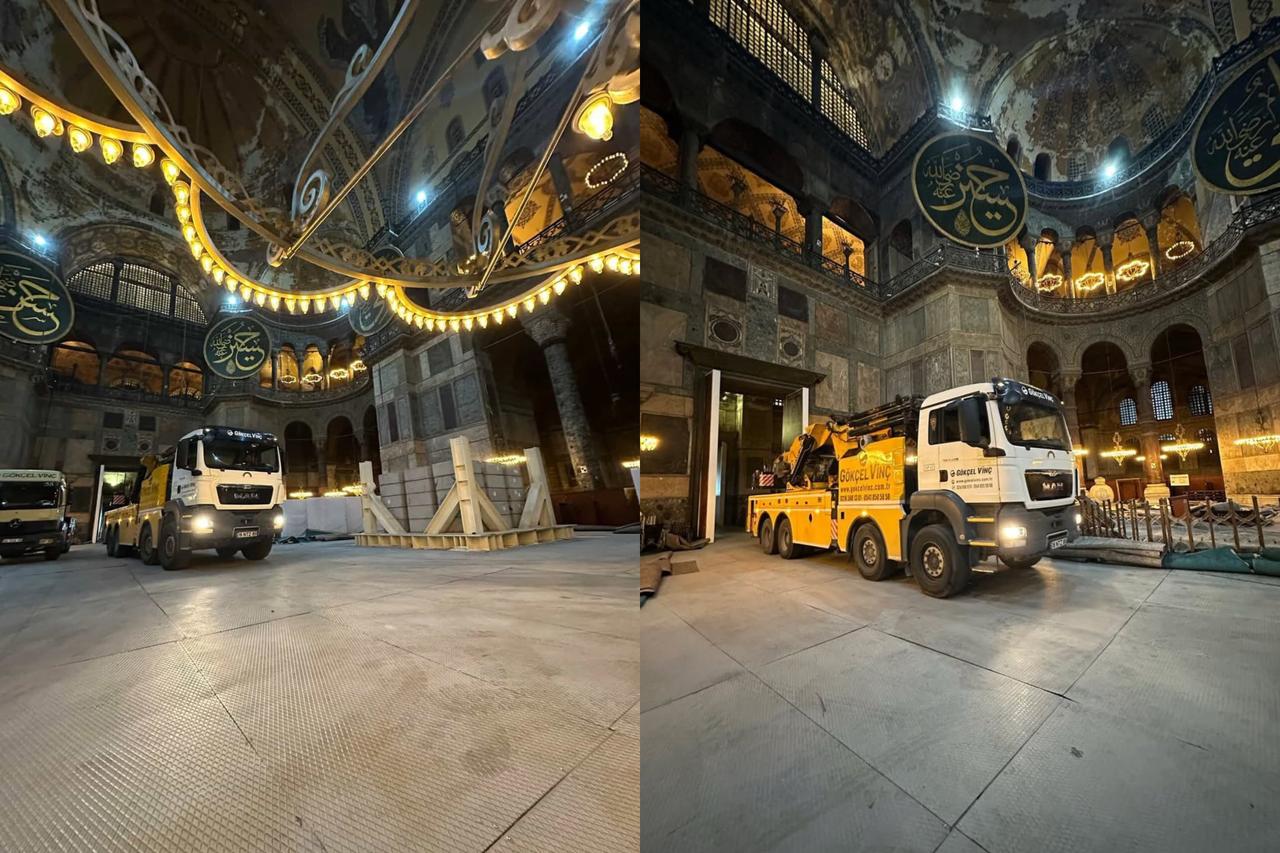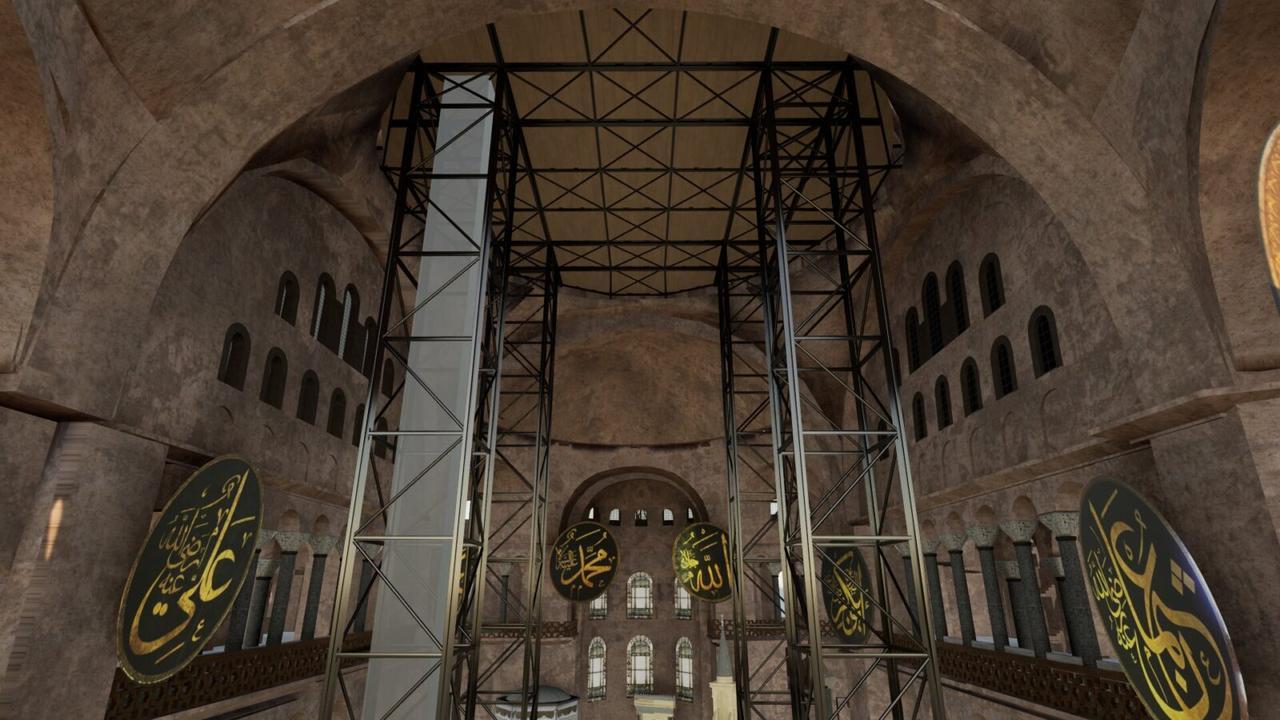
A heavy crane truck seen inside Hagia Sophia Grand Mosque has raised concerns over how its latest restoration is being carried out.
Photographs from inside the building show a heavy truck-mounted crane driven onto the historic floor and parked on temporary protective panels, prompting questions over whether the fragile ground is being adequately protected while work continues.
In an earlier statement on social media, Culture and Tourism Minister Mehmet Nuri Ersoy said strengthening work at the mosque would continue without interrupting worship.
He described Hagia Sophia Grand Mosque as “1486 years old” and stated that restoration and reinforcement efforts were underway both inside and outside the building.
According to his message, “the main dome is entering the widest and most comprehensive restoration process in its history,” and the dome would be made more resistant to earthquakes. At the same time, the original character of the monument would be carefully preserved.
The new images, however, have shifted attention from the upper structure to what is happening on the floor, where the restoration team has brought in heavy vehicles.

Photographs from the site document high-tonnage trucks being driven into the mosque during the works.
One of the most striking scenes shows a large crane truck positioned on the historic floor surface inside the building. Another image captures the crane in the area known as the Imperial Gate, the main ceremonial entrance of the structure, which is often associated with imperial processions.
These scenes circulated widely on social media, where users questioned why such vehicles were allowed onto the original floor of a monument of this age. While the images have been discussed publicly, the relevant authorities have not yet issued a statement responding to the concerns raised about the method used.

Closer inspection of the photographs suggests that a temporary protective layer has been placed under the crane’s tyres. The floor appears to have been covered with panels so that the rubber wheels do not rest directly on the historic surface. These panels are typically made from high-density polyethylene (HDPE) sheets, heavy-duty composite ground protection panels, or steel-supported temporary floor plates designed to act as a buffer between the vehicle and the ground.
According to a restorer scholar, the system visible in the photographs appears relatively simple. The panels do not look like thick, interlocking elements that lock into each other, but rather flat sheets that could be prone to slipping. Some areas seem to remain without panel coverage, meaning that the load may not be distributed evenly across the entire surface under and around the vehicle.
According to a scholar, who spoke to Türkiye Today on the condition of anonymity, Hagia Sophia's floor does not consist of a single, solid layer. Under the visible surface, there are mosaics, original stone pavements, and, in some places, voids described as similar to crypt-like spaces. Concentrated loads and vibrations on such a layered and locally hollow structure could transmit stress to these elements and, over time, damage or deform them.

In the case of heavy vehicles entering historic buildings, the assessment notes that a more complex load-distribution system is normally required.
This would typically involve composite ground protection panels that are significantly thicker, that interlock with each other and that spread the weight of the vehicle across a much wider area. This refers to panels with a thickness of at least three to five centimetres, combined with timber sleepers or steel plates below them to distribute the pressure further.
In some cases, according to the same scholar, the weight of the vehicle is taken away from the most sensitive parts of the floor by placing it on steel grating or similar structures, so that the original ground is not exposed to concentrated stress. By contrast, the system seen in the Hagia Sophia photographs appears to be limited to a layer of panels laid on the floor, without a clearly visible secondary load-spreading structure beneath them.

The photographs also allow an approximate technical description of the vehicle itself. The crane appears to be mounted on a MAN truck chassis with three axles and six wheels, indicating a compact, medium-class crane truck. Based on the size of the boom, the proportions of the hydraulic cylinders, and the general configuration of the body, the crane is assessed as belonging to the 25 to 35 ton lifting-capacity range.
The scholar notes that most vehicles of this type fall into the 30-ton class, and suggests that the crane in the images is likely to have an average lifting capacity of around 30,000 kilograms. The combined weight of the truck and the crane superstructure is estimated in the range of roughly 20 to 26 tons. The relatively compact body and manoeuvrability of the vehicle would have made it easier to drive into a confined space such as the interior of Hagia Sophia.
The same assessment underlines that, in a space of this kind, the crane is expected to remain in the medium-tonnage category so as not to overwhelm the floor. Even so, the axle loads and the limited area of the tyre contact patches are considered significant for a layered and sensitive ground.

According to a different expert, the risks associated with this type of use can include panel deformation, transmission of concentrated pressure to original stones or mosaics beneath the panels, and the possibility of local subsidence in areas where voids exist under the floor.
Vibrations from the vehicle and its operations may also affect the dome and walls through micro-cracking over time, while crane manoeuvres could cause panels to shift and increase pressure on specific points.